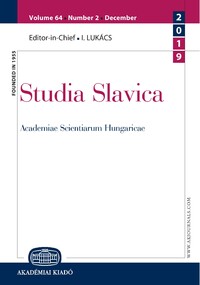Формальна і семантична структури дериватів y говорах української мови: проблема кореляції
Formal and Semantic Structures of Derivatives in the Dialects of the Ukrainian Language: the Problem of Correlation
Author(s): Tetiana YastremskaSubject(s): Semantics
Published by: Akadémiai Kiadó
Keywords: dialects of the Ukrainian language; adjectives; compounds; derivatives; formal structure; semantic structure; semantic opposition; motivation; correlation
Summary/Abstract: The corpus of adjectives with the root -гор- (-гір-, -гур-) amounts to more than 60 units. It describes the orientation of objects in the space as well as identifies the spatial qualification of an object and models the coordinate system of the linguistic (resp. dialectal) worldview. The author scrutinizes the semantics of the adjectives: unprefixed derivatives of the 1st and 2nd degrees of derivation (гíрний / гóрний, горáвий, горúстий, горíшний, гірськúй, гóряний, горíський, etc.); prefixal-suffixal formations (згíрний, згірнúстий, загíрний, нагíрний, пагористий, etc.), and compounds (крутогóрий, плоскогíрний, простогíрний, etc.). The semantic structure of adjectives is analyzed within two semantic subcomplexes: ‘the top of the object’ and ‘high / low limit’. The subcomplexes unite the meanings of the adjectives, which are structured hierarchically. All meanings (components of the semantic structure) are illustrated by examples of dialectal speech. These meanings represent different aspects of the Ukrainians’ life. The analysed units represent semantic and typical features for the south-western dialects of the Ukrainian language. The sources of the study are historical and regional dictionaries (by Ye. Zhelekhivskyi, S. Nedilskyi, P. Biletskyi-Nosenko, D. Yavornytskyi, B. Hrinchenko, etc.) and texts as well as linguistic atlases. Semantic changes, as based on the analysis of historical sources and manuscripts of the Ukrainian language from the 11th century, were recorded at different historical stages. It is possible to identify the specific features of the perception of the world and differences in the worldview of dialect speakers, their knowledge, and collective experience, and represent the specific features of dialect nomination, derivation, and semantics. The dialectal data provided in the 7 comparative tables of the lexeme’s derivation and semantics, and what is more, semantic changes of the adjectives гíрськúй / гóрський and горíшний. The oldest fixations of derivatives from the 11th century and the semantic evolution of the words are documented. The analysis of the formal and semantic structures of derivatives proved that the semantics of the base word is the basis for the formation of the semantics of derivatives.
Journal: Studia Slavica Academiae Scientiarum Hungaricae
- Issue Year: 65/2020
- Issue No: 1
- Page Range: 209-230
- Page Count: 22
- Language: Ukrainian
- Content File-PDF

